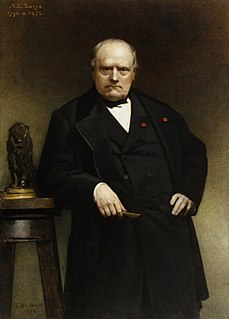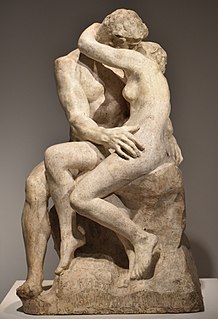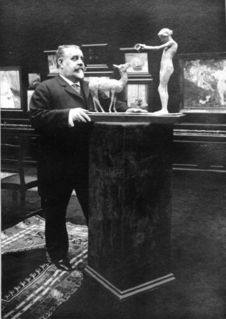
François Auguste René Rodin was a French sculptor generally considered the founder of modern sculpture. He was schooled traditionally and took a craftsman-like approach to his work. Rodin possessed a unique ability to model a complex, turbulent, and deeply pocketed surface in clay. He is known for such sculptures as The Thinker, Monument to Balzac, The Kiss, The Burghers of Calais, and The Gates of Hell.

Christie's is a British auction house founded in 1766 by James Christie. Its main premises are on King Street, St James's in London and in Rockefeller Center in New York City. It is owned by Groupe Artémis, the holding company of François-Henri Pinault. Sales in 2015 totalled £4.8 billion. In 2017, the Salvator Mundi was sold for $400 million at Christie's in New York, at the time the highest price ever paid for a single painting at an auction.

François Rude was a French sculptor, best known for the Departure of the Volunteers, also known as La Marseillaise on the Arc de Triomphe in Paris. (1835–36). His work often expressed patriotic themes, as well as the transition from neo-classicism to romanticism.

Antoine-Louis Barye was a Romantic French sculptor most famous for his work as an animalier, a sculptor of animals. His son and student was the known sculptor Alfred Barye.

Rembrandt Bugatti was an Italian sculptor, known primarily for his bronze sculptures of wildlife subjects. During World War I, he volunteered for paramedical work at a military hospital in Antwerp, an experience that triggered in Bugatti the onset of depression, aggravated by financial problems, which eventually caused him to commit suicide on 8 January 1916 in Paris, France. He was 31 years old.

The Kiss is an 1882 marble sculpture by the French sculptor Auguste Rodin. The embracing nude couple depicted in the sculpture appeared originally as part of a group of reliefs decorating Rodin's monumental bronze portal The Gates of Hell, commissioned for a planned museum of art in Paris. The couple were later removed from the Gates and replaced with another pair of lovers located on the smaller right-hand column.

François Pompon was a French sculptor and animalier. Pompon made his Salon debut in 1879, exhibiting a statue of Victor Hugo's Cosette. He was a pioneer of modern stylized animalier sculpture. He was not fully recognized for his artistic accomplishments until the age of 67 at the Salon d'Automne of 1922 with the work Ours blanc. Pompon died in Paris, France, on 6 May 1933.

The Little Fourteen-Year-Old Dancer is a sculpture begun c. 1880 by Edgar Degas of a young student of the Paris Opera Ballet dance school, a Belgian named Marie van Goethem.

Georges Petit was a French art dealer, a key figure in the Paris art world and an important promoter and cultivator of Impressionist artists.
Pierre-Jules Mêne was a French sculptor and animalier. He is considered one of the pioneers of animal sculpture in the nineteenth century.

Count Alfred Émilien O'Hara van Nieuwerkerke was a French sculptor of Dutch descent and a high-level civil servant in the Second French Empire. He is also notable as the lover of Princess Mathilde Bonaparte, after her estrangement from her husband Anatoly Nikolaievich Demidov, 1st Prince of San Donato.

Tête de femme is a plaster-modelled, bronze-cast sculpture by Pablo Picasso. Dora Maar, Picasso's lover at the time, was the subject of the work which was originally conceived in 1941. Four copies of the bust were cast in the 1950s, several years after the relationship ended.
Alfred Barye "Le Fils" or Alf Barye was a French sculptor, of the Belle Époque, pupil of his father the artist Antoine-Louis Barye. In cooperation with Émile-Coriolan Guillemin, Barye did the artwork for "The Arab Warrior Knight on Horseback". Included in Barye's oeuvre were animalier bronzes as well as Oriental subjects. At his father's request, he signed his work as "fils" to differentiate his work from his father's.

Eternal Springtime is a c. 1884 sculpture by the French artist Auguste Rodin, depicting a pair of lovers. It was created at the same time as The Gates of Hell and originally intended to be part of it.

Family Group is a sculpture by Henry Moore. It was his first large-scale bronze sculpture, and his first large bronze with multiple castings. Made for Barclay School in Stevenage, it evolved from drawings in the 1930s, through a series of models to bronze castings in 1950–51. It also one of the last important sculptures that Moore developed from preliminary drawings: in future, he worked mainly from found objects, maquettes and models.

The Rudier Foundry was a foundry run by Alexis Rudier and his son Eugène Rudier (1875–1952). It worked with some of the most notable sculptors of the 19th and 20th centuries, including Auguste Rodin, Antoine Bourdelle, Gustave Miklos, Aristide Maillol and Daumier. Their casts were signed "Alexis RUDIER Fondeur PARIS".

Young Woman with a Serpent is a c. 1885 sculpture by Auguste Rodin, realised in several media. The artist later used the figure in his 1905 Adam and Eve.

The Waltz or The Waltzers is a sculpture by French artist Camille Claudel. It depicts two figures, a man and a woman, locked in an amorous embrace as they dance a waltz. The work was inspired by Claudel's burgeoning love affair with her mentor and employer Auguste Rodin. Various versions were made from 1889 to 1905, initially modelled in plaster, and later cast in bronze. Examples are held by the Musée Rodin and the Musée Camille Claudel.

French sculpture has been an original and influential component of world art since the Middle Ages. The first known French sculptures date to the Upper Paleolithic age. French sculpture originally copied ancient Roman models, then found its own original form in the decoration of Gothic architecture. French sculptors produced important works of Baroque sculpture for the decoration of the Palace of Versailles. In the 19th century, the sculptors Auguste Rodin and Edgar Degas created a more personal and non-realistic style, which led the way to modernism in the 20th century, and the sculpture of Pablo Picasso, Georges Braque, Marcel Duchamp and Jean Arp.

Iris, Messenger of the Gods is a powerful idea for all people and women is a bronze sculpture by Auguste Rodin. A plaster model, created between 1891 and 1894, was cast in bronze by Fonderie Rudier at various times from about 1895. Iris is depicted with her right hand clasping her right foot and her naked body posed provocatively with her legs spread wide, displaying her genitalia.